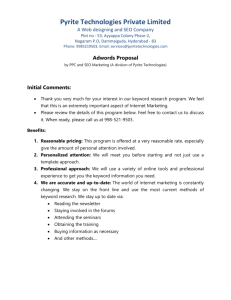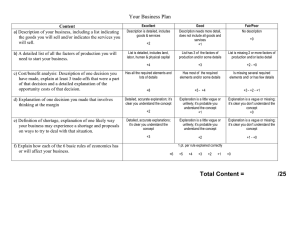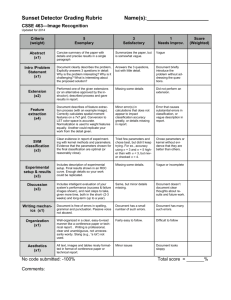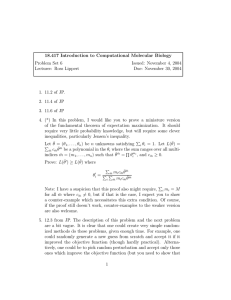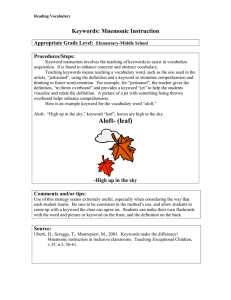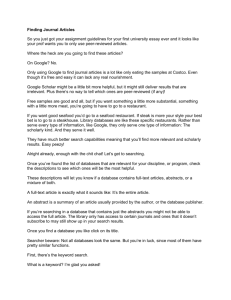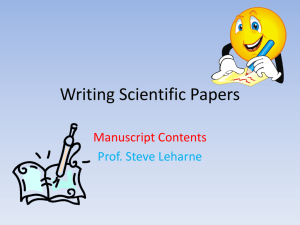How to Write an Engineering Abstract: A Guide
advertisement
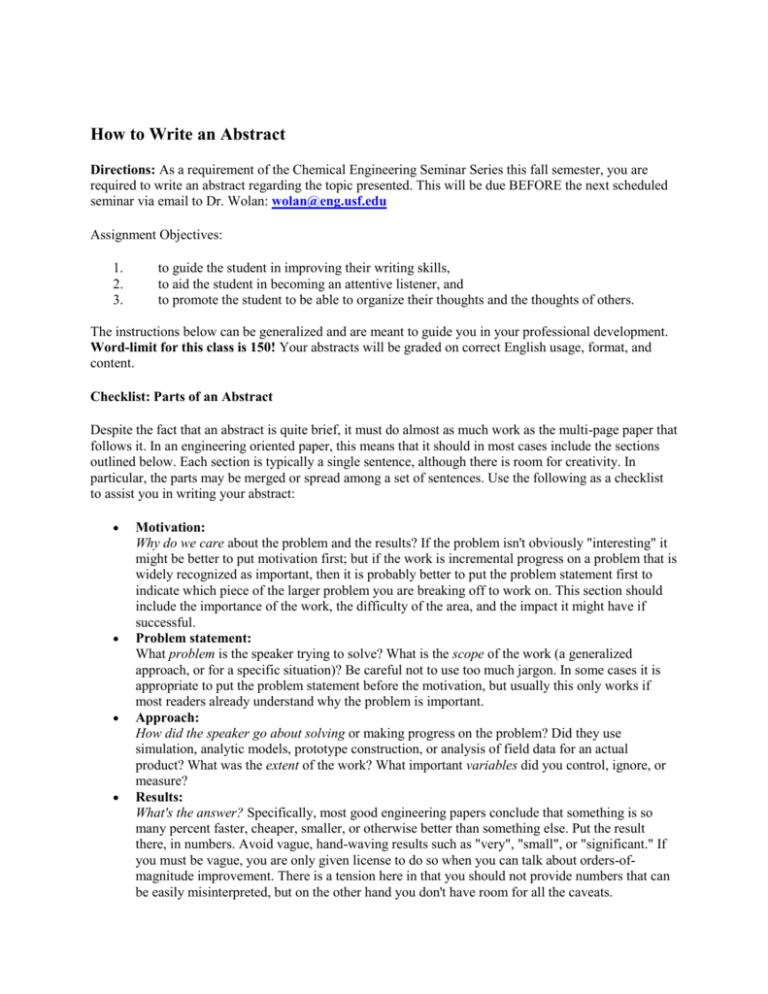
How to Write an Abstract Directions: As a requirement of the Chemical Engineering Seminar Series this fall semester, you are required to write an abstract regarding the topic presented. This will be due BEFORE the next scheduled seminar via email to Dr. Wolan: wolan@eng.usf.edu Assignment Objectives: 1. 2. 3. to guide the student in improving their writing skills, to aid the student in becoming an attentive listener, and to promote the student to be able to organize their thoughts and the thoughts of others. The instructions below can be generalized and are meant to guide you in your professional development. Word-limit for this class is 150! Your abstracts will be graded on correct English usage, format, and content. Checklist: Parts of an Abstract Despite the fact that an abstract is quite brief, it must do almost as much work as the multi-page paper that follows it. In an engineering oriented paper, this means that it should in most cases include the sections outlined below. Each section is typically a single sentence, although there is room for creativity. In particular, the parts may be merged or spread among a set of sentences. Use the following as a checklist to assist you in writing your abstract: Motivation: Why do we care about the problem and the results? If the problem isn't obviously "interesting" it might be better to put motivation first; but if the work is incremental progress on a problem that is widely recognized as important, then it is probably better to put the problem statement first to indicate which piece of the larger problem you are breaking off to work on. This section should include the importance of the work, the difficulty of the area, and the impact it might have if successful. Problem statement: What problem is the speaker trying to solve? What is the scope of the work (a generalized approach, or for a specific situation)? Be careful not to use too much jargon. In some cases it is appropriate to put the problem statement before the motivation, but usually this only works if most readers already understand why the problem is important. Approach: How did the speaker go about solving or making progress on the problem? Did they use simulation, analytic models, prototype construction, or analysis of field data for an actual product? What was the extent of the work? What important variables did you control, ignore, or measure? Results: What's the answer? Specifically, most good engineering papers conclude that something is so many percent faster, cheaper, smaller, or otherwise better than something else. Put the result there, in numbers. Avoid vague, hand-waving results such as "very", "small", or "significant." If you must be vague, you are only given license to do so when you can talk about orders-ofmagnitude improvement. There is a tension here in that you should not provide numbers that can be easily misinterpreted, but on the other hand you don't have room for all the caveats. Conclusions: What are the implications of the answer or result? Is it going to change the world (unlikely), be a significant "win", be a nice hack, or simply serve as a road sign indicating that this path is a waste of time (all of the previous results are useful). Are the results general, potentially generalizable, or specific to a particular case? Other Considerations An abstract must be a fully self-contained, capsule description of the paper. It can't assume (or attempt to provoke) the reader into flipping through looking for an explanation of what is meant by some vague statement. It must make sense all by itself. Some points to consider include: Meet the word count limitation. If your abstract runs too long, either it will be rejected or someone will take a chainsaw to it to get it down to size. Your purposes will be better served by doing the difficult task of cutting yourself, rather than leaving it to someone else who might be more interested in meeting size restrictions than in representing your efforts in the best possible manner. An abstract word limit of 150 to 200 words is common. Any major restrictions or limitations on the results should be stated, if only by using "weaselwords" such as "might", "could", "may", and "seem". Think of a half-dozen search phrases and keywords that people looking for the work might use. Be sure that those exact phrases appear in your abstract, so that they will turn up at the top of a search result listing. Usually the context of a paper is set by the publication it appears in. But, if the paper appears in a somewhat un-traditional venue, be sure to include in the problem statement the domain or topic area that it is really applicable to. Some publications request "keywords". These have two purposes. They are used to facilitate keyword index searches, which are greatly reduced in importance now that on-line abstract text searching is commonly used. However, they are also used to assign papers to review committees or editors, which can be extremely important to your fate. So make sure that the keywords you pick make assigning your paper to a review category obvious (for example, if there is a list of conference topics, use your chosen topic area as one of the keyword tuples). Conclusion Writing an efficient abstract is hard work, but will repay you with increased impact on the world by enticing people to read your publications. Make sure that all the components of a good abstract are included in the next one you write.
